 Jennifer Krasinski
Jennifer Krasinski
A question of transgression and its evolutions in the first exhibition of the artist’s work since his death last year.

Hermann Nitsch: Selected Paintings, Actions, Relics, and Musical Scores, 1962–2020, installation view. Courtesy Pace Gallery.
Hermann Nitsch: Selected Paintings, Actions, Relics, and Musical Scores, 1962–2020, Pace, 510 West Twenty-Fifth Street, New York City,
through April 29, 2023
• • •
It’s best to approach Hermann Nitsch: Selected Paintings, Actions, Relics, and Musical Scores, 1962–2020—a thoughtful if dissatisfying show of the Viennese Actionist—as a case study in what becomes of a transgressive gesture over time. This suggestion isn’t pure projection on my part: Nitsch’s legacy, by Pace Gallery’s design, is the heart of the matter here. The artist, who was born in 1938, died last year at the age of eighty-three, and this is the first posthumous exhibition of his work. It coincides with the publication of an English translation of his 1995 autobiography, Hermann Nitsch: Life and Work, and was boosted in its opening week by four presentations of Fountain II, a six-hour performance and installation by the young New York–based artist Miles Greenberg. According to the gallery’s press release, Greenberg’s offering was intended to “situate Nitsch’s experimental practice within a contemporary context.” It seems the Austrian’s relevance, how he will be read, is a source of some anxiety.

Hermann Nitsch: Selected Paintings, Actions, Relics, and Musical Scores, 1962–2020, installation view. Courtesy Pace Gallery. Pictured: Hermann Nitsch, Schüttbild, 1997. Oil and blood on jute.
Alongside fellow Actionists Günter Brus, Otto Muehl, and Rudolf Schwarzkogler, Nitsch is considered a patenonkel of a radical strain of performance art that placed bodies on the front lines of cultural production. Their work could be gory, scatological, violent, and involve self-harm and animal sacrifice, but for a generation that grew up during the Nazi occupation and World War II—“I was scared to death all the time,” Nitsch recalled of his childhood—repression was the prevailing menace. The Actionists were determined to excavate and express the sum total of human experience, of reality, no matter how excruciating—for themselves, their collaborators, or their audiences.
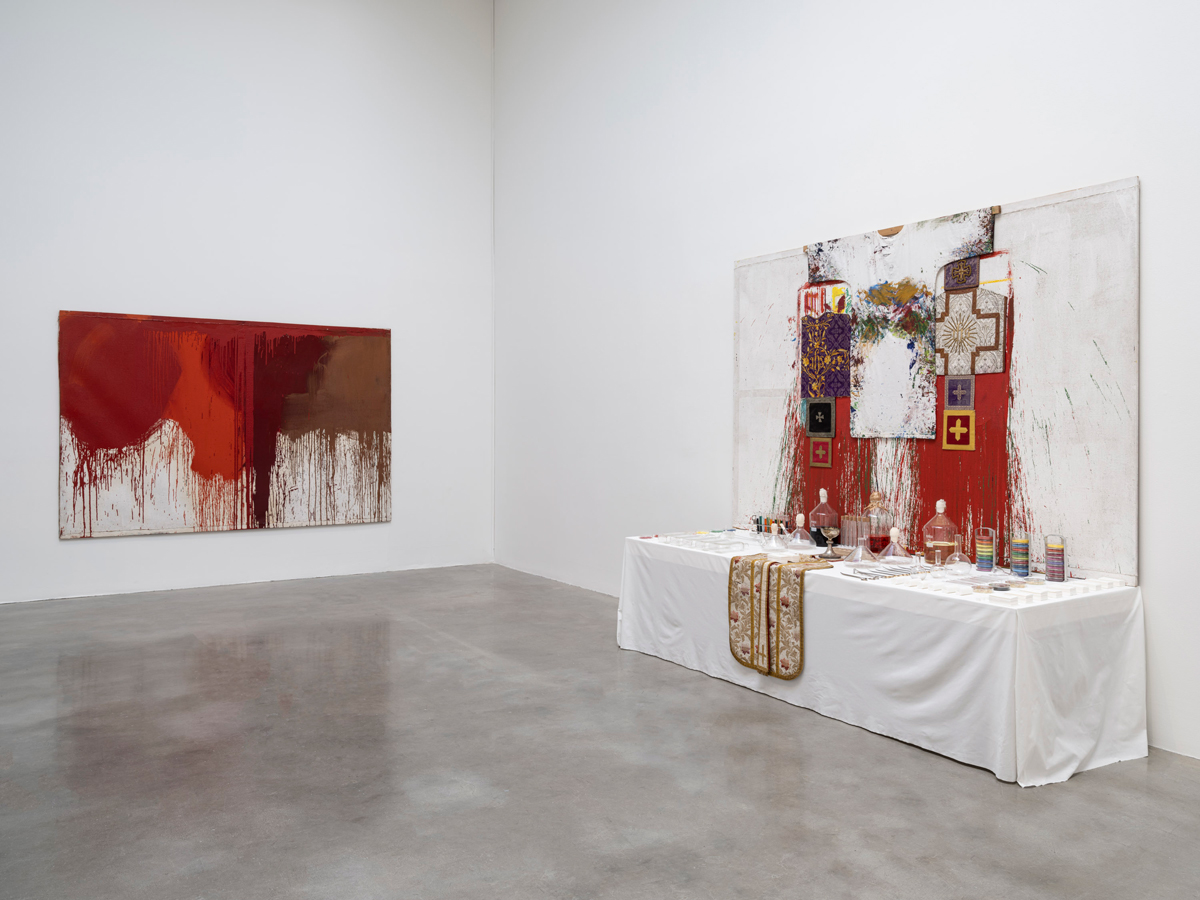
Hermann Nitsch: Selected Paintings, Actions, Relics, and Musical Scores, 1962–2020, installation view. Courtesy Pace Gallery.
For Nitsch, raised Catholic, the real was not to be confused with, or limited to, the profane. In the mid-1950s, he began fomenting his renowned six-day performance Orgies Mysteries Theatre, which he reworked and restaged throughout his life. (In late May, an incarnation of its third part, “Day of Dionysus,” will be presented at Prinzendorf Castle in Austria.) A synthesis of Christian and pagan rites, rituals, myths, and symbols, the project was his attempt at a Gesamtkunstwerk, a total work of art. Its epic festivities—which Mike Kelley, who participated in a Los Angeles iteration, admired for being so “tightly choreographed”—included music, meals, and the making of Nitsch’s Schüttbilds (splatter paintings), twelve of which are on view at Pace.
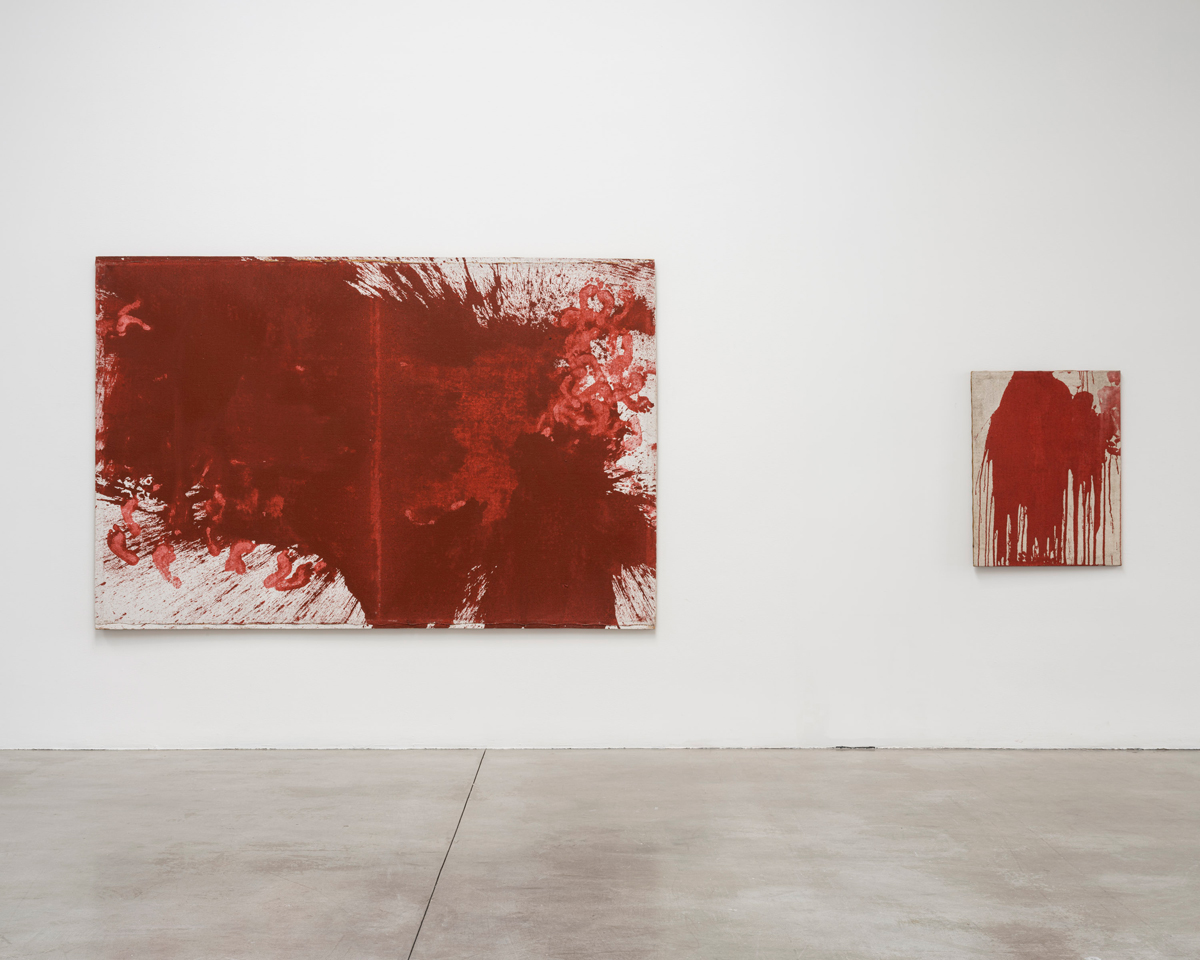
Hermann Nitsch: Selected Paintings, Actions, Relics, and Musical Scores, 1962–2020, installation view. Courtesy Pace Gallery. Pictured, left: Hermann Nitsch, Schüttbild, 1983. Oil on jute.
You might not know just from looking that many of these gruesomely hued abstractions are outpourings from a grand performance, but you can’t miss their drama. The application of paint seems almost feral. Oils and acrylics in ominous reds, muddy browns, and pitch blacks are splashed and splattered onto jute, running down in long rivulets. On some—see the Schüttbilds from 1992 and 1997—a thick, tar-like pigment is smeared by hand, the artist’s fingers leaving twisting grooves across their surfaces. Crimson footprints punctuate another painting here from 1983. A shirt may appear at the top center of a piece, a stand-in for the artist, or for some other sacrificial body. On three occasions in this show, Nitsch’s paint mingles with animal blood. Though these works are possessed of an absolute brutality, they are rarely if ever morbid. The near-compulsive gestures that repeat throughout, the apparent physicality with which the paintings are executed, point to an embrace of violence as integral, natural, to death, birth, and rebirth.
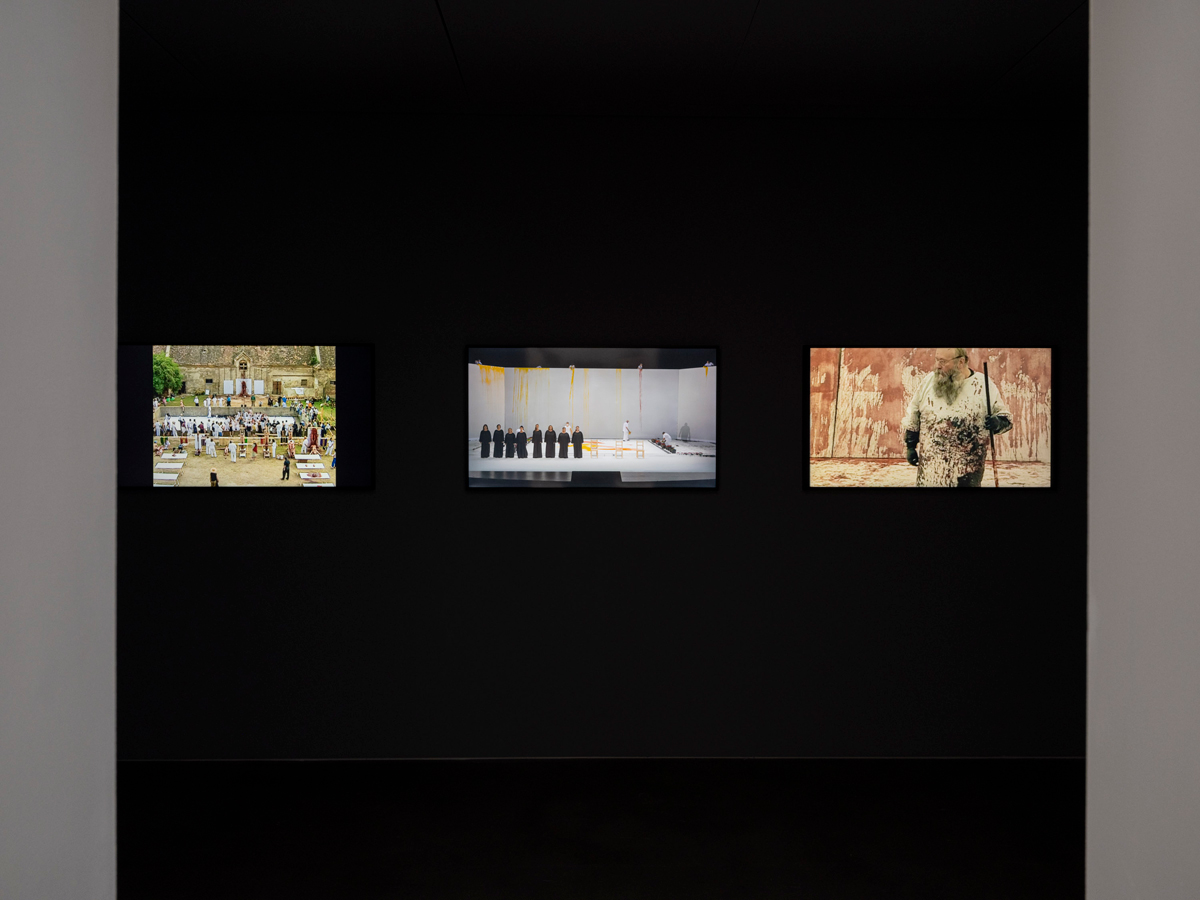
Hermann Nitsch: Selected Paintings, Actions, Relics, and Musical Scores, 1962–2020, installation view. Courtesy Pace Gallery.
A trio of videos play in a small room at the back of the gallery, each a documentary of one of Nitsch’s live events—and much-needed context for the rest of the exhibition. This isn’t a failing. After all, the paintings are only part of his art, and such is the ephemeral nature, and conceptual order, of performance: it resists re-presentation, refuses commodification. In the video of the full performance of Orgies Mysteries Theatre from 1998, one beholds Nitsch at work on the Schüttbilds, wearing an all-white outfit, stained with paint, that looks as much like a butcher’s apron as it does an artist’s smock. There is footage of animal slaughter and the pouring of blood into the mouths of nude men and women tied up to be crucified. Bells ring, gongs are struck. A choir sings, and a brass band marches around an open garden. Cow, pig, and lamb guts are tossed with grapes and tomatoes, then stomped on by a giddy group of performers. An audience is present throughout, maintaining their distance, ducking and dodging, trying to keep their clothes clean.
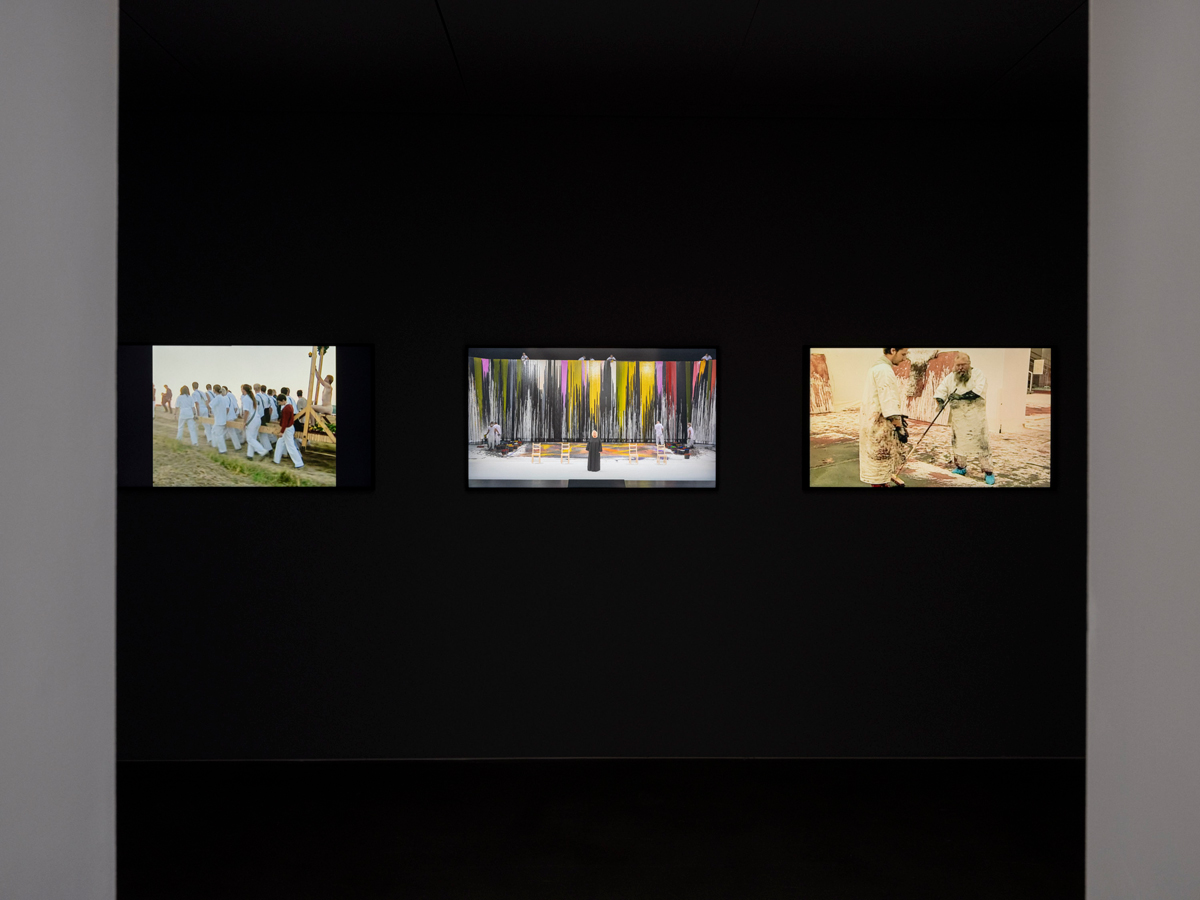
Hermann Nitsch: Selected Paintings, Actions, Relics, and Musical Scores, 1962–2020, installation view. Courtesy Pace Gallery.
And that is where the real action is—and was always meant to be. Even on video, and even now, the excessive images Nitsch created for Orgies Mysteries Theatre are horrifying, sublime. Look away if you need to, but despite its wildest flourishes and most nauseating sequences, there is nothing to see that isn’t, in the end, an elemental part of life—for better and for worse. I initially had my thought about tracing the fate of a transgressive gesture while watching the video of Nitsch’s 2021 staging of Wagner’s Die Walküre for the Bayreuth Festival. As singers in black gowns stand at the front of the stage, assistants clad in white toss a rainbow assortment of paints from plastic pitchers across a canvas laid on the floor; above, others pour streams of the colors down a blank backdrop. Notwithstanding his palpable enthusiasm for the project, it felt as if Nitsch had cast his own work in the role of décor. I felt a similar deflation when, at the back of the gallery, I stood before a table laid like an altar with oddball bits of glassware, petri dishes filled with bright pigments, a studious set of test tubes, a richly embroidered chasuble, and a chalice, all posed to receive their high priest. Though I’m never averse to overkill, I always cringe at overstatement.
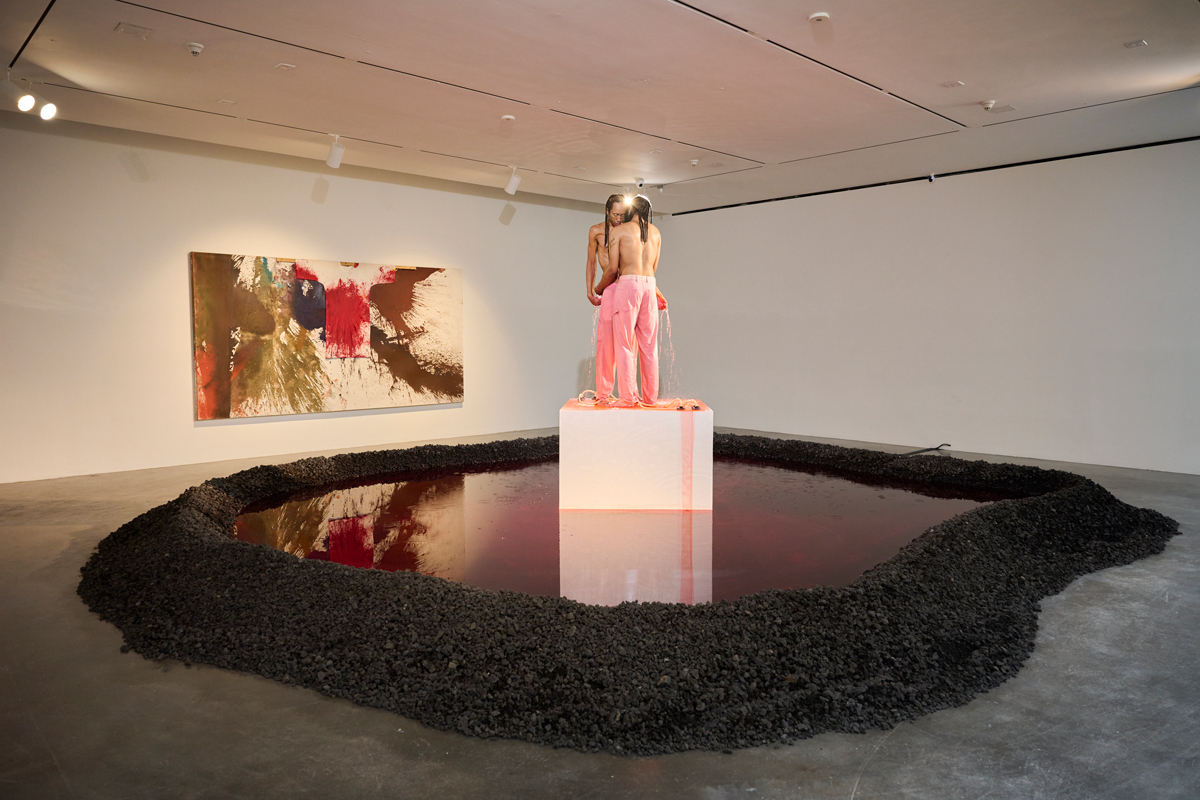
Miles Greenberg, Fountain II, 2023. Presented as part of Hermann Nitsch: Selected Paintings, Actions, Relics, and Musical Scores, 1962–2020. Courtesy Pace Gallery.
The watering down of Nitsch was my first take on Greenberg’s performance. I could be forgiven since the show’s overall arc moves a viewer from images of blood gushing from animals’ jugulars to the aestheticized, ceremonial violence of his paintings, between two of which, in the final room, Greenberg and performer Niall Jones stood face-to-face on a plinth at the center of a fountain. Outfitted alike in white trousers turned pink by the red-tinted water pouring from tubes wound around their arms, the two men (for the duration that I watched) were gently moving together, leaning into one another, nearly caressing, connected but somehow never connecting. And I found myself mesmerized, and realized that I had gotten Greenberg’s piece wrong. Such tenderness, enacted over time—what more transgressive act could there be right now?
Jennifer Krasinski is a writer and critic based in Brooklyn.